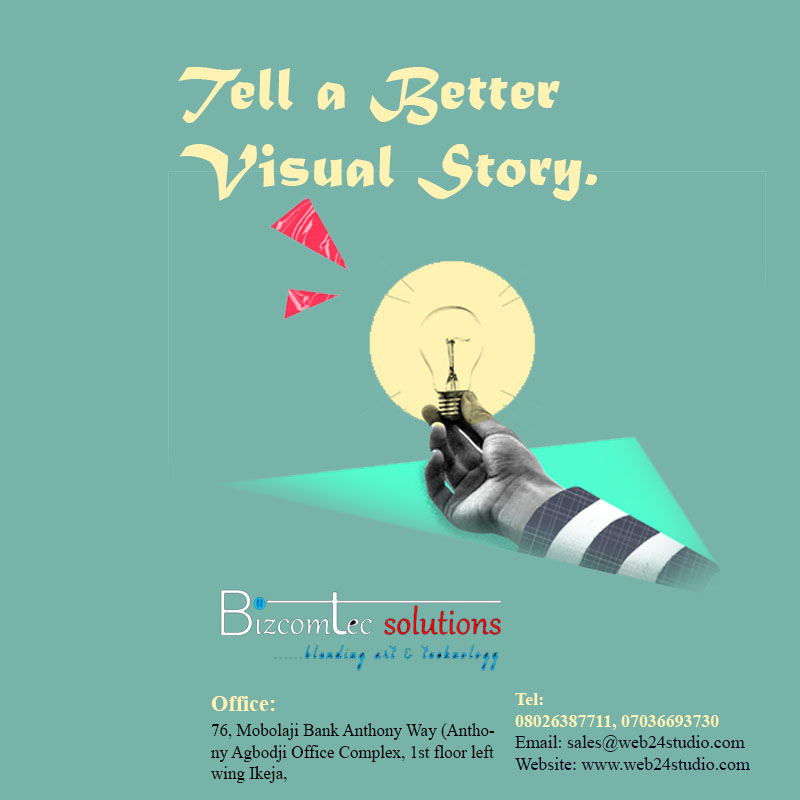Digital Marketing Agency, Website designers in Lagos
Digital Marketing Agency, Website designers in Lagos

Brands have long relied on visual content and the power of visual storytelling to connect with consumers and sell products, and for good reason. People process visual information thousands of times faster than text, and retain 80% of what they see vs. 20% of what they read.
As social beings, we’re also hardwired to visually sense emotions — and visual storytelling builds on emotions and feelings. With 90% of purchase decisions made subconsciously, the experience the visual story creates is the key to its success.
What’s changed pretty dramatically over the last several years is the sheer volume of visual media we engage with daily, the pace with which we’re consuming that visual information, and the number of connection points and devices we utilize along the way.
More than 4.6 billion pieces of digital content are produced every day. At the same time, the average human attention span has dropped from 12 seconds to about eight in less than two decades.
Many recommendations for creating powerful visual story experiences focus on the creative elements of visual storytelling. But in today’s digital world, how your customer experiences that well-crafted visual story matters. There is an actual physical experience the viewer undergoes, and it is critical that marketers consider not only what will be viewed, but how, when and where it will be viewed.
Most global brands research their buyer personas to understand their customer’s needs, concerns and buying journey. It’s how a visual storyteller understands their audience.
These personas are an overwhelming influence on visual storytelling creative. However, an often overlooked aspect of the persona are the buyer’s “glasses” — how will they actually view the visual story — and the buyer’s glasses can vary widely.
Along with attention to visual media selection, consider how those visuals are viewed. It’s worth the effort to plan for multiple visual treatments and formats to ensure an optimal visual storytelling experience across the platforms most used by your buyer personas.
Social platforms are key channels for visual storytelling experiences that can promote more engagement and social sharing with customers. Visuals are magnets for sharing, with content with visual elements receiving up to 40% more shares than text heavy content. Mobile apps, and particularly social platforms, can offer a way to deliver richer, more engaging visuals and a better user experience.
Unfortunately, the formats and standards across social platforms and mobile apps are inconsistent. Creating separately optimized visuals for every platform and obsessing over microdata to guide image selection may be a bother, but making sure your customer is experiencing the visual story without any cut-off images or distortion is critical to its success on these platforms.
Marketers for global brands should consider regional differences across their buyer personas. This encompasses not only the selection of visual media and the storytelling arc, but also the regional preferences for platforms that will be used for viewing the stories.
Consumers are increasingly favoring brands that reflect their local values, and according to Nielsen, 75% of global consumers say that brand origin is a key purchase driver. However, the relationship a consumer forms with a brand can also be a top reason to select a global brand over a local one.
By placing an emphasis on local preferences for visual impact and viewing platforms, visual storytellers at global companies can build experiences that emotionally tie viewers to their brands.
Evolution has ingrained us with the ability to “thin slice,” the science of first-impressions which Malcolm Gladwell made famous in his book “Blink.” The idea is that we make snap judgments based on patterns that we see in a very small amount of time. Sight is our primary sensory input results in 90% of the information our brains process is visual.
It should be no surprise that our thin-slicing for visuals is extremely fast. Where most studies say brands have seven seconds to make a first impression with their marketing, for a visual that drops to half a second.